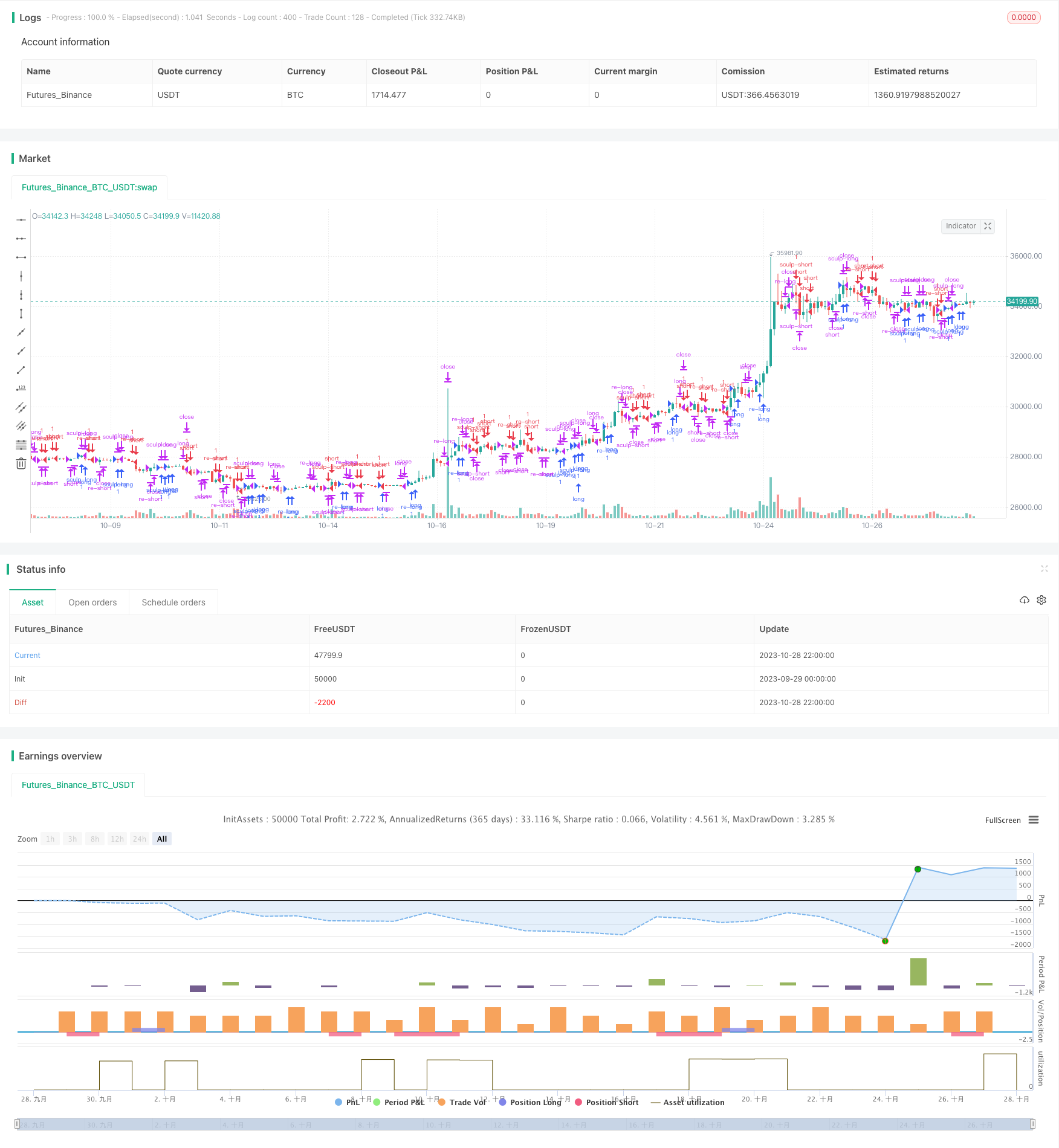
概述
该策略综合利用MACD指标的金叉死叉信号、K线收盘价格与中位线的关系、价格震荡特征来判断入场和出场时机,同时设定再入场和修正入场机制,以期获得更多交易机会的同时控制风险,实现稳定收益。
策略原理
该策略主要基于以下几点原理:
用MACD的分析快线和慢线的金叉死叉来判断多头和空头市场,以及具体的入场点。
用K线收盘价格与中位线的关系来判断多空趋势是否结束,以及出场点。
设定再入场机制,在MACD本轮行情结束后,如果继续符合趋势就再次入场,增加盈利机会。
设定修正入场机制,如果价格出现部分调整但还未反转,就追加仓位,这个属于趋势内部调整。
综合以上几点,动态调整仓位,在趋势中尽可能获得更多盈利,并在趋势结束时快速离场。
具体来说,策略首先判断MACD的快线和慢线是否发生金叉或死叉现象,如果金叉就做多,如果死叉就做空;然后判断K线是否收盘触碰中位线,如果触碰就判断为趋势结束而平仓。
此外,策略还设置了再入场机制,也就是在原始方向的趋势结束后,如果MACD继续显示同一方向的信号,策略会再次开仓追踪趋势;同时也设置了修正入场机制,如果价格出现小幅调整但还未全面反转,策略会适当加仓,这属于趋势中的正常回调行为。
通过这些设定,策略能够在趋势中动态调整仓位,进出场次数更多,在控制风险的前提下获得更高收益。
策略优势
这种策略综合运用了多个指标,有以下主要优势:
MACD可以识别趋势及反转点,确定具体入场点。
收盘价与中位线关系判断能准确判断趋势结束。
再入场机制增加了开仓次数,提升了资金利用效率。
修正入场机制及时补仓,能充分捕获趋势行情。
策略操作频率高但风险可控,容易获得较高的盈利因子。
各项参数可调整,可以针对不同品种和行情进行优化。
策略思路清晰易于理解,代码编写简洁,实盘操作方便。
回测数据充足,可靠性较高,实盘易于验证效果。
策略风险
该策略也存在以下主要风险:
MACD发出虚假信号的概率,需要组合其他指标进行验证。
大级别止损设置过小可能被特大行情震出场外。
再入场和修正入场增加操作频率,需要控制资金利用率。
反弹行情中修正入场可能带来较大亏损。
交易品种和参数设置需要优化,不适用于全部品种。
需要持续回测与优化,根据市场调整参数。
实盘中需要考虑滑点成本的影响。
对应风险管理措施包括:设置止损止盈确保单笔亏损有限;评估资金利用率,保持合理现金备用金;针对品种选择合适的参数组合进行回测;持续关注行情特征的变化以优化参数;在回测与模拟中考虑滑点成本的影响。
策略优化方向
该策略可以从以下几个方面进行进一步优化:
组合其他指标进行信号验证,提高信号准确率。如KDJ指标等。
设置自适应动态止损止盈标准。
优化再入场和修正入场的条件逻辑。
分品种参数优化,设定最优参数组合。
优化资金利用比例,设定再入场与修正入场的资金限制。
结合量能指标,避免反弹行情中的追仓亏损。
增加离场机制,如设置移动止损等。
考虑将策略封装成为交易机器人,实现自动化交易。
增加实盘考虑因素,如滑点成本。
通过这些优化,可以进一步提升策略的稳定性、适应性、自动化程度及实盘效果。
总结
本策略整合运用MACD指标的交易信号、K线收盘价格分析和多次入场机制,在抓住趋势的同时控制风险,是一种效率较高的量化交易策略思路。该策略具有操作频率高、资金利用率好、实现难度低等优势,但也需要关注风险控制和策略优化,具有很强的实用价值和拓展空间。如果结合机器人技术实现自动化,将可以成为一种非常实用的量化交易方案。
/*backtest
start: 2023-09-29 00:00:00
end: 2023-10-29 00:00:00
period: 2h
basePeriod: 15m
exchanges: [{"eid":"Futures_Binance","currency":"BTC_USDT"}]
*/
// This source code is subject to the terms of the Mozilla Public License 2.0 at https://mozilla.org/MPL/2.0/
// © Puckapao
//@version=4
// strategy(title="MACD", shorttitle="MACD", overlay=true, initial_capital=10000.00, currency="USD", default_qty_type=strategy.cash, default_qty_value=10000.00)
// Getting inputs
reenter_delay = input(title="Re-enter Delay", type=input.integer, defval=2)
sculp_delay = input(title="Sculp Delay", type=input.integer, defval=4)
fast_length = input(title="Fast Length", type=input.integer, defval=12)
slow_length = input(title="Slow Length", type=input.integer, defval=26)
src = input(title="Source", type=input.source, defval=close)
signal_length = input(title="Signal Smoothing", type=input.integer, minval = 1, maxval = 50, defval = 9)
sma_source = input(title="Simple MA(Oscillator)", type=input.bool, defval=false)
sma_signal = input(title="Simple MA(Signal Line)", type=input.bool, defval=true)
ema_period = input(title="EMA Period", type=input.integer, defval=21)
// Get date
startDate = input(title="Start Date", type=input.integer,
defval=19, minval=1, maxval=31)
startMonth = input(title="Start Month", type=input.integer,
defval=09, minval=1, maxval=12)
startYear = input(title="Start Year", type=input.integer,
defval=2017, minval=1800, maxval=2100)
endDate = input(title="End Date", type=input.integer,
defval=31, minval=1, maxval=31)
endMonth = input(title="End Month", type=input.integer,
defval=3, minval=1, maxval=12)
endYear = input(title="End Year", type=input.integer,
defval=2021, minval=1800, maxval=2100)
// STEP 2:
// Look if the close time of the current bar
// falls inside the date range
inDateRange = true
reenter_cnt = 0
reenter_cnt := nz(reenter_cnt[1])
sculp_cnt = 0
sculp_cnt := nz(sculp_cnt[1])
close_cnt = 0
close_cnt := nz(close_cnt[1])
on_long = false
on_long := nz(on_long[1])
on_short = false
on_short := nz(on_short[1])
sculp = false
reenter = false
slowdown = false
ema = ema(close, ema_period)
// Plot colors
col_grow_above = #26A69A
col_grow_below = #FFCDD2
col_fall_above = #B2DFDB
col_fall_below = #EF5350
col_macd = #0094ff
col_signal = #ff6a00
// Calculating
fast_ma = sma_source ? sma(src, fast_length) : ema(src, fast_length)
slow_ma = sma_source ? sma(src, slow_length) : ema(src, slow_length)
macd = fast_ma - slow_ma
signal = sma_signal ? sma(macd, signal_length) : ema(macd, signal_length)
hist = macd - signal
// plot(hist, title="Histogram", style=plot.style_columns, color=(hist>=0 ? (hist[1] < hist ? col_grow_above : col_fall_above) : (hist[1] < hist ? col_grow_below : col_fall_below) ), transp=0 )
// plot(macd, title="MACD", color=col_macd, transp=0)
// plot(signal, title="Signal", color=col_signal, transp=0)
cross_up = crossover(macd, signal)
cross_down = crossunder(macd, signal)
if (inDateRange)
over_macd = macd > 0 and signal > 0 ? true : false
under_macd = macd < 0 and signal < 0 ? true : false
over_water = close > ema ? true : false
under_water = close < ema ? true : false
slowdown := hist >= 0 ? (hist[1] > hist ? true : false) : (hist[1] > hist ? false : true)
reenter := hist >= 0 ? (hist[1] < hist ? true : false) : (hist[1] > hist ? true : false)
sculp := (hist >= 0 ? (hist[1] > hist ? true : false) : (hist[1] < hist ? true : false))
if(reenter == true)
if(reenter_cnt < reenter_delay)
reenter_cnt := reenter_cnt + 1
else
if(reenter_cnt > 0)
reenter_cnt := reenter_cnt - 1
if(sculp == true)
if(sculp_cnt < sculp_delay)
sculp_cnt := sculp_cnt + 1
else
if(sculp_cnt > 0)
sculp_cnt := sculp_cnt - 1
if(slowdown == false)
if(close_cnt < 2)
close_cnt := close_cnt + 1
else
close_cnt := 0
// plotchar(fork_cnt, "fork count", "")
// plotchar(spoon_cnt, "spoon count", "")
// Entry
if (cross_up == true)
strategy.entry("long", strategy.long, comment = "long", alert_message = "long")
on_long := true
on_short := false
if (cross_down == true)
strategy.entry("short", strategy.short, comment = "short", alert_message = "short")
on_short := true
on_long := false
// Sculp bottom / top
if (sculp == true and sculp_cnt >= sculp_delay)
if (hist >= 0)
strategy.entry("sculp-short", strategy.short, comment = "sculp-short", alert_message = "sculp-short")
else
strategy.entry("sculp-long", strategy.long, comment = "sculp-long", alert_message = "sculp-long")
sculp_cnt := 0
sculp := false
// Re-Entry
if (reenter == true and reenter_cnt >= reenter_delay)
if (hist >= 0)
strategy.entry("re-long", strategy.long, comment = "re-long", alert_message = "re-long")
else
strategy.entry("re-short", strategy.short, comment = "re-short", alert_message = "re-short")
reenter_cnt := 0
reenter := false
// Close
strategy.close("long", when = slowdown, comment = "close long", alert_message = "close long")
strategy.close("short", when = slowdown, comment = "close short", alert_message = "close short")
strategy.close("re-long", when = slowdown, comment = "close re-long", alert_message = "close re-long")
strategy.close("re-short", when = slowdown, comment = "close re-short", alert_message = "close re-short")
strategy.close("sculp-long", when = slowdown, comment = "close sculp-long", alert_message = "close sculp-long")
strategy.close("sculp-short", when = slowdown, comment = "close sculp-short", alert_message = "close sculp-short")
if (slowdown)
if (hist >= 0)
on_long := false
else
on_short := false
plotchar(slowdown, "close", "")
plotchar(reenter, "reenter", "")
plotchar(reenter_cnt, "reenter count", "")
plotchar(sculp, "sculp", "")
plotchar(sculp_cnt, "sculp count", "")